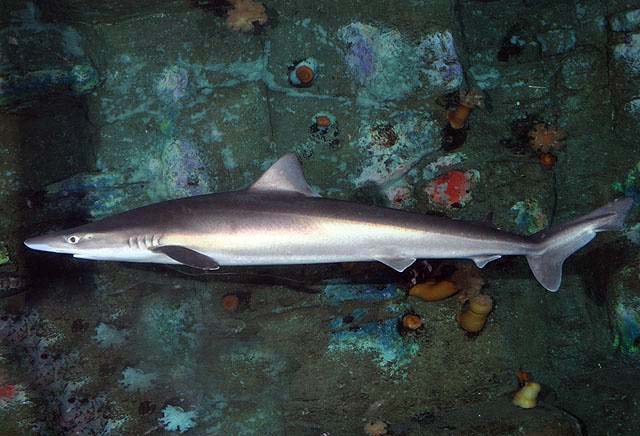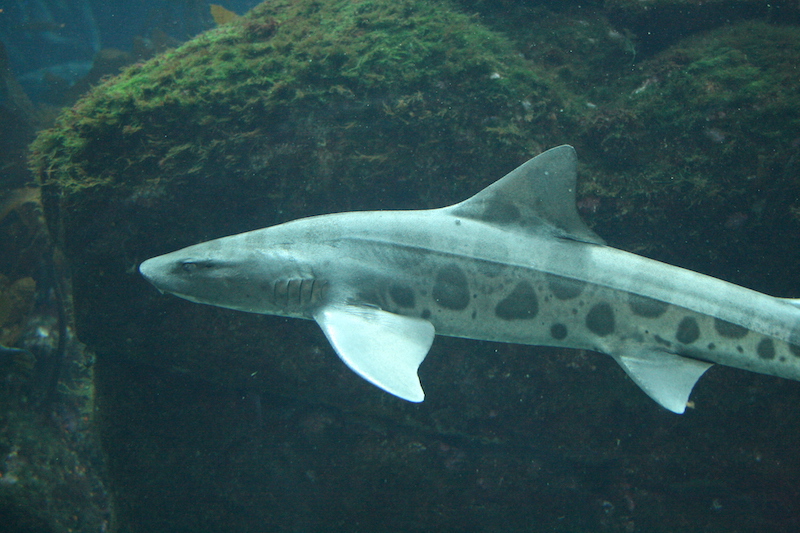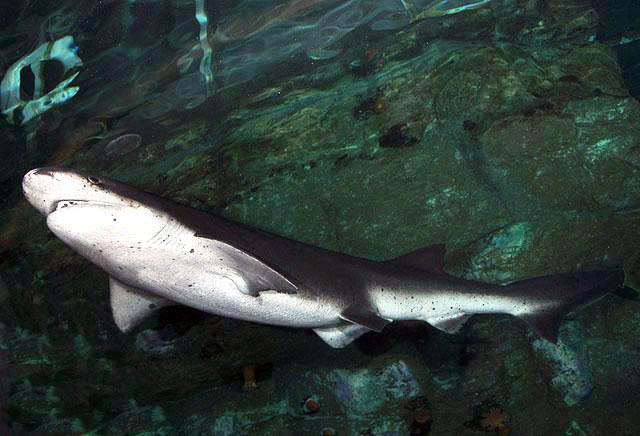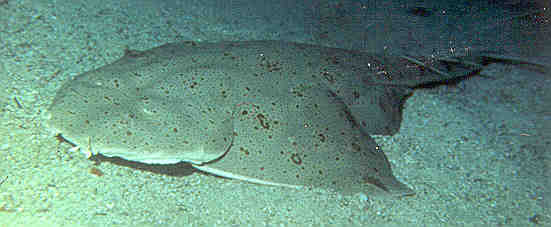Huntington Beach, California, is one of the surf capitals of the world — its nickname is “Surf City.”
And it does have some of the best surfing all year, thanks to its prime location between ocean currents, which bring up consistent swells no matter the season.
While Southern California may be a major surfing destination, it’s also well-known for its consistent sunny weather and general beach vibes along the coast, making for phenomenal recreation activities from surfing and swimming to hiking, biking, and relaxing on the beach.
Located between Los Angeles and San Diego, this beach paradise is easy to get to whether you live elsewhere in California or are looking to fly in.
But if you’re looking to visit this scenic town, you might have one big question:
Does Huntington Beach, CA have sharks?

Huntington Beach’s waters are home to many different types of sharks, including:
- School sharks
- Leopard sharks
- Blue sharks
- Sevengill sharks
- Pacific angel sharks
- Great white sharks
However, beachgoers shouldn’t worry. Shark encounters, let alone attacks, in Huntington Beach are exceedingly rare — with only 4 recorded attacks… ever. Even the fabled great white shark very rarely gets anywhere near the shoreline here.
Let’s take a closer look at the types of sharks that live near Huntington Beach, photos, shark attack history and statistics, and more.
Types of Sharks in Huntington Beach, CA
While it’s not unusual to have a shark sighting near Huntington Beach, physical shark encounters are very uncommon.
This part of California is home to some of the largest protected marine areas in the world. Marine life across the board is abundant here!
Huntington Beach itself is part of a strip of coastline with ideal waters for natural marine nurseries — warm, calm water is an ideal spot to raise young.
Sharks are one of those animals, and many of California’s sharks take advantage of this incredible habitat.
Here are some of the most common sharks you might find in these waters:
School Shark

As implied by their name, school sharks tend to travel in groups, especially during the warmer spring and summer months.
They prefer shallow kelp beds, are generally very cautious of divers and other humans. They can be easily spooked by rapid movements.
School sharks are average in size, generally between 5 and 7 feet long. They’re a darker gray in color, with white undersides.
Leopard Shark

Leopard sharks are one of the species that takes its name directly from its appearance.
Their bodies are light grayish-brown, with dark blotches and saddles that resemble the spots of a leopard.
They’re mid-sized when it comes to sharks, typically averaging between two and five feet, though larger ones have been seen.
Leopard sharks are a commonly observed shark, both for scientific and recreational purposes, since they’re considered docile and generally not harmful to humans.
Since they inhabit shallow, sandy areas and estuaries closer to shore, it’s not uncommon to come across them when snorkeling.
Blue Shark

Blue sharks are some of the world’s most migratory sharks, with similar movement patterns as great whites.
A single shark can travel across its ocean basins (like the entire Pacific Ocean) several times in a lifetime.
Blue sharks are also some of the most visually pleasing, making them highly photographed.
Their bodies are very sleek, and shaped like torpedoes, with their dorsal fins standing out with its deep indigo blue color.
Blue sharks aren’t aggressive, but do seem to be curious of humans.
Sevengill Shark

The sevengill shark is found in plenty of places around the world, and while its range is massive, it’s only found in a handful of places regularly.
Huntington Beach, and Southern California’s many marine reserves more broadly, is one of them. The most common area for Sevengills in these waters is around La Jolla Cove.
Sevengills are named for their unusual number of gills — seven.
Considering you likely won’t be close enough to count them, they’re also identifiable by their broad and blunt snouts and just one posterior dorsal fin.
They prefer to be close to the sea floor, roaming through rocky reefs or kelp forests.
Pacific Angel Shark

The Pacific angel shark is one of the most unique in appearance. They have large pectoral and pelvic fins, and their overall shape is very flat, resembling a ray, with eyes on the top of their heads rather than the side.
They’re still predators, though, and they’re known as ambush predators that hide out in the sand.
Understandably, Pacific angel sharks keep close to the sea floor, and usually inhabit areas with sandy bottoms near kelp forests.
Great White Shark

Great white sharks are the ocean’s top predator, and one of the top predators in the world overall.
They’re also one of the largest shark species, sometimes reaching over 20 feet in length.
Great whites are a migratory species, meaning they don’t stick to one region for very long and usually prefer the open ocean, as opposed to coastal waters that would put them close to beachgoers.
The exception is young sharks, which are smaller and sometimes need to venture closer to shore for food.
Still, the closest they get to beaches is offshore dive sites, which can be found along the California coast.
History of Shark Attacks near Huntington Beach
While Southern California is known for its world-class beaches, it’s unfortunately also well-known for its sharks.
That isn’t to say that shark encounters with humans are common (shark attacks across the world are extremely rare), but rather that the waters along this iconic coastline are home to a large number of shark species, as well as natural nursery grounds.
Due to relatively calm and warm ocean waters found just offshore, California water makes an ideal nursery location for pregnant sharks.
That warm water just offshore, along with a significant amount of shallow water, also supports a relatively large number of juvenile sharks — younger sharks enjoy warm water, and shallow water is easier hunting grounds for young sharks of just about every species.
Huntington Beach sharks, like any in Southern California, do have a history with humans.
However, even in a region that’s considered ideal habitat for sharks, the chances of a dangerous encounter are almost zero. You’re much more likely to experience an injury just going about your daily life than you are to experience a shark attack.
In this region, shark numbers are the highest from April through October.
This is the time of year when sharks give birth to young, and since this area is so supportive of young marine animals, shark numbers can grow rapidly.
Sharks are present in California waters year-round. Often, adult sharks are simply passing through on a migration, and even when numbers are high, sharks generally leave people alone.
Some beaches along the Pacific coastline have statistically seen more shark attacks than others, but every region along California, Oregon, and Washington has had shark sightings at some point in recorded history — most of them harmless.
By just the number of shark attacks in recorded history, the Huntington Beach area has seen four attacks.
That’s the same number as some of the beaches that are considered the most dangerous.
Why is Huntington Beach not considered dangerous?
Well, this number at Huntington Beach amounts to four attacks in history among thousands of people in the water per day, meaning that as a percentage, the number of people attacked by sharks at Huntington Beach is far, far lower than even 1 percent.
Other beaches with four attacks are considered more dangerous because they are remote, and only frequented by a handful of surfers per season.
California shark attacks are most common among surfers. Huntington Beach sharks rarely come close enough to shore to lead to an encounter with the average beachgoer.
Other activities that do technically pose a risk are any where you may be exposed to open water, like swimming, kayaking, paddleboarding, or scuba diving.
Even then, sharks are rarely drawn to humans. We’re not they’re prey, and it’s agreed that most shark encounters result simply from a shark mistaking a human for a seal or other animal that would be its prey. Some dangerous encounters do result from aggressive sharks, usually only when provoked, but for the most part, sharks pretty much ignore people, even when we are sharing the same water.
Being aware of shark behavior and helping to reduce the stigma around them is actually a great step towards being educated about these powerful marine animals — one of the ocean’s valuable species. And, being educated about sharks is an important step towards being safe.
Avoiding Huntington Beach Shark Attacks (Tips & Things to Know)
In Southern California, the greatest odds of encountering a shark are while surfing, and, of course, this iconic coastline is known worldwide for its unbeatable surf spots.
To the average beachgoer, the risk of a run-in with a Huntington Beach shark are quite low, and the risk of getting bitten by a shark here are next to zero.
While the risks are low, it’s always important to be knowledgeable and prepared. Behaviorally, Huntington Beach sharks are just like any others in the world, and so are the tips to be aware of and precautions to take when planning a beachtime vacation.
Here are several things to be aware of, so that you stay safe from sharks while enjoying the Southern California sun:
- Don’t swim alone. Sharks are generally uninterested in people, and even less interested in groups of people. If an agitated shark is nearby, it’s more likely to approach a lone person. Swimming too far from shore can also isolate you. Plus, it puts you farther away from help in the event that some problem does happen (whether that’s from a shark or not!).
- Stay out of the water at night, and during dawn and dusk. Sharks are most active at twilight hours, like early in the morning and in the evening. Simply being in the water at these times increases your chances of encountering a nearby shark. Additionally, these low-light hours in the water are sharks’ natural habitat — they thrive and can see well, while people have worsened eyesight at these times. This means that if there is a shark in the water, it can see you better than you can see it.
- Avoid wearing anything shiny. This goes for both jewelry and swimwear. Shiny accessories can catch the light and appear similar to fish scales, making you more closely resemble a shark’s natural prey. A shark mistaking a human for its prey is believed to be the main cause of shark bites across the world.
- Avoid excessive splashing. Erratic movements and splashing can mimic the movements of other marine animals like seals, which can draw sharks’ attention. While this is easy enough for people to keep in mind, it’s also a good reminder to keep pets out of the water for the same reason that their movements can mimic that of a shark’s prey.
- Don’t harass a shark. Even if there are sharks present nearby, they are unlikely to bother people. The exception is if a shark feels threatened or aggravated, particularly if that’s as a result of an interaction with people. Do as the sharks do, and simply leave them alone.
Wrapping Up
Southern California is well-known for both its surfing and recreation activities, as well as its nearby marine life — including sharks.
The region is a natural nursery ground for young sharks, so it attracts and is home to larger numbers of sharks than beach vacationers may expect; however, the chances of an encounter with a shark are extremely low.
Huntington Beach has one of the lowest percentages of shark bites and attacks along the western seaboard, and as long as you take the necessary precautions, sharks won’t be bothering you on your Huntington Beach vacation.
For more shark guides, check out:
Hope this helps!